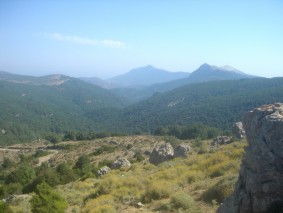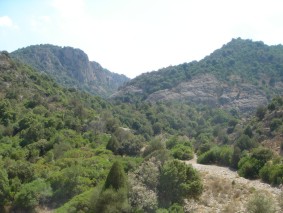| Back to Homepage |
 |
|
Other places to go birdwatching in Sardinia |
|
|
Gennargentu The Gennargentu is the highest mountain range in Sardinia, reaching up to just over 1800m. There are several 'protected' areas, the largest of which is the Parco Nazionale del Golfo di Orosei just south of Nuoro. The word 'protected' is in inverted commas because in fact there is a lot of livestock grazing throughout this park, and quite a high human population presence. Nonetheless, some areas are very remote and are home to some of the last stands of primary holm oak forest in Sardinia. Funtana Bona, just south of Orgosolo was recommended to me, and proved to have a good variety of upland species. As well as the birds, Mouflon Sheep, Sardinian Red Deer, Sardinian Wild Cat (both separate subspecies) and Pine Martin can all be found here. Notable bird species include Golden Eagle, Buzzard, Alpine Swift, Woodlark, Crag Martin, Grey Wagtail, Hoopoe, Raven, Stonechat, Coal Tit, Marmora's Warbler, Firecrest, Linnet, Hawfinch, and Citril Finch. Rock Thrush should find the habitat ideal, but so far I haven't seen this species in Sardinia. To get to Funtana Bona, head for Nuoro, then follow signs for Oliena, then Orgosolo. In Orgosolo take the road that winds up into the mountains and keep going straight on to Funtana Bona. When the road turns into a track, keep going a little further. There is parking just ahead. A dirt road continues up through the holm oak forest into the hills. There is a nice mixture of forest, macchia scrub and 'grazed woodland' up here. Alternatively, to see similar species, you could follow the coastal road that runs south from Dorgali to Arbatax. |
Gennargentu: Looking north from Funtana Bona |
|
Laguna di Nora The Laguna di Nora is the site of the largest breeding colony of Audouin's Gulls in the whole of Italy, and a globally important colony for a species that was once the rarest and most endangered seagull in the world. Fortunately, numbers have increased well since the 1980s, but it still remains a difficult bird to see anywhere in Europe. The colony at the Laguna di Nora is all the more remarkable because, unlike most other colonies of Audouin's Gull around the Mediterranean, it is not on a rocky coastal island, but on the flat delta islands of a small river which runs into the lagoon. The lagoon and the land on which the colony is situated, are now part of a privately-owned reserve, which is being managed excellently. As well as the colony, there is a sea turtle and cetacean rehabilitation centre and an aquarium showing all the local fish species, both in the sea and the lagoon. If you book in advance, it is possible to go on a guided canoe trip among the delta islands where the gulls breed, an experience I would really recommend. Prices and contact details can all be found on the website: http://www.lagunadinora.it As well as the Audouin's Gulls, the lagoon is good for migrant species during the spring and autumn. At other times of the year species that can be seen include: (summer) Purple Heron, Little Egret, Kingfisher, Black-winged Stilt, Common Tern, Spotted Flycatcher, Zitting Cisticola; (autumn, winter and spring) Grey Heron, Great Egret, Little Egret, Sandwich Tern, Slender-billed Gull, Black-headed Gull, Kentish Plover, Grey Plover, Lapwing, Little Grebe, Wigeon, Shoveler, Black Redstart. The Laguna di Nora is located about 30km south west of Cagliari along the coastal road. Follow signs for Pula, and then in Pula, follow the signs for Nora (an archaeological attraction, the site of a former Roman town). The entrance to the Laguna is right next to the entrance to the archaeological site. |
|
|
Monte Arcosu Monte Arcosu is the only WWF reserve in Sardinia, created to preserve part of a vast wilderness that is home to a healthy population of the indigenous Sardinian Red Deer. The reserve centre itself is only open at weekends, however, if you get permission from the warden, you can walk along the trails that lead up to Monte Arcosu on weekdays. As you would expect from WWF, the reserve is very well-maintained, with lots of information boards about all the animal, bird, amphibian and insect species in the area. There is a good variety of habitat along the trails, ranging from mature holm oak forest to upland macchia scrub. Bird species here include: Golden Eagle, Buzzard, Goshawk, Sparrowhawk, Scops Owl, Turtle Dove, Nightjar, Raven, Bee-eater, Grey Wagtail, Spotted Flycatcher, Woodchat Shrike, Cetti's Warbler, Blackcap, Nightingale, Coal Tit, Tree Sparrow and Cirl Bunting. The reserve is located only about 20km west of Cagliari. Head west out of the city along the coastal road and take the turn off to Capoterra, from where the road to the reserve is well signposted. The reserve itself is on the northern edge of a vast, steep mountain range. Very few roads penetrate into this area, and it remains probably the largest tract of holm and cork oak forest in the Mediterranean basin. To get right into the middle of this wilderness, there is a road, shown on most maps that runs from Capoterra to Santadi. For most of the 37 kilometres, this road is a dirt track, although it is well maintained with few potholes. It is a very quiet road, and you can stop and birdwatch almost anywhere along its length. Part way up into the mountains there are some tracks running off on both sides which you can walk or cycle along to get into the thick of the forest. |
Monte Arcosu WWF Reserve
|

